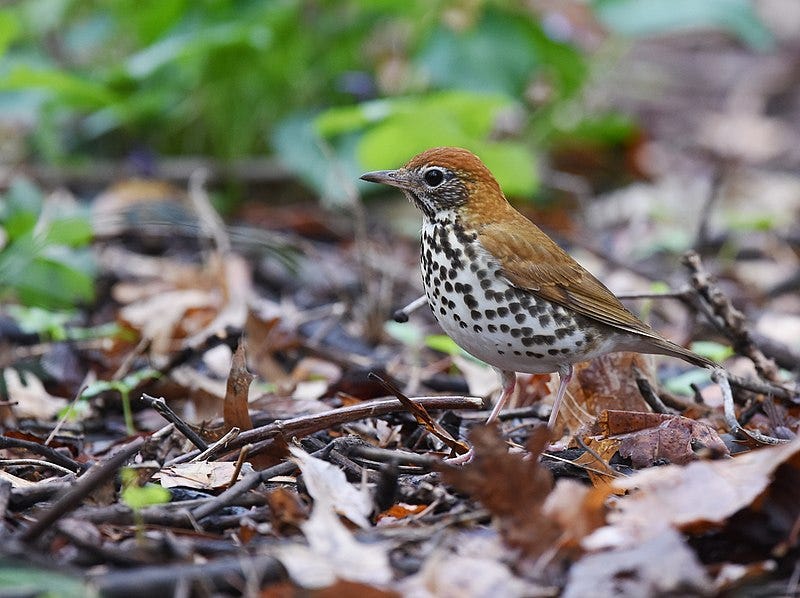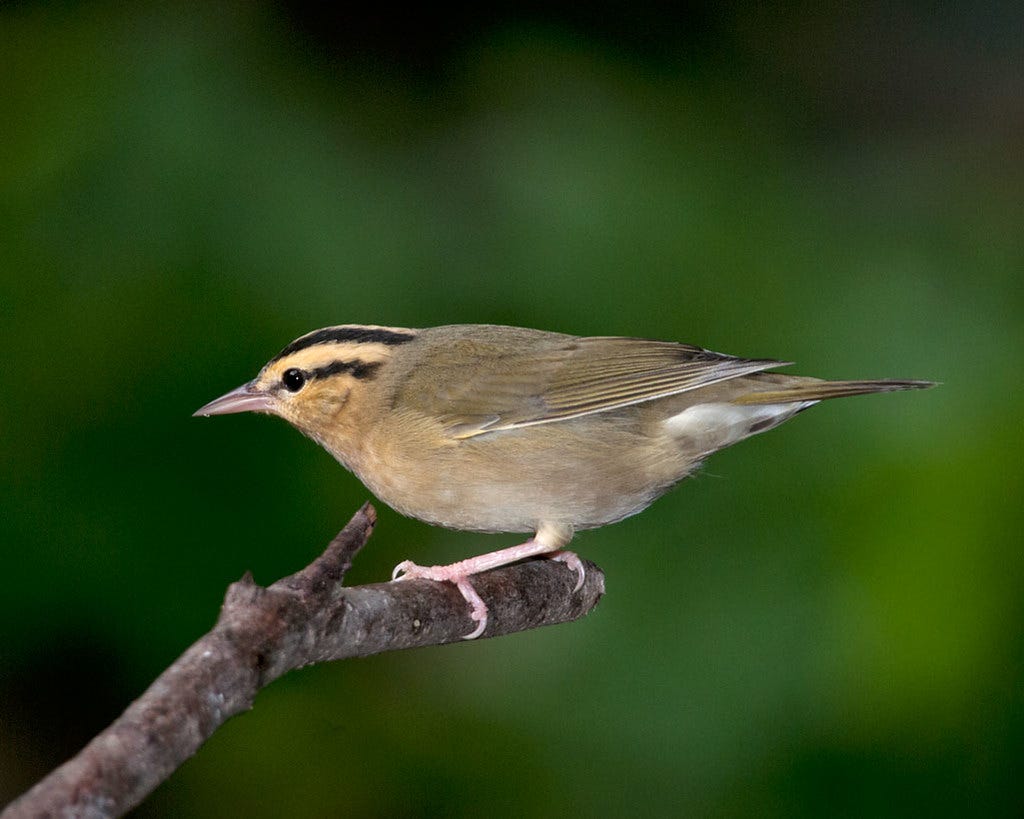Migration 2024
Its finally May — the month when the spring migration really picks up and a firehose of colorful, tropical birds is let loose upon the Eastern forests of the United States! I’ve been feeling little droplets here and there while going about my everyday business — a prairie warbler stopping over in my parent's yard, a tanager singing beneath the noise of a tractor at work — and finally decided that it was time to stop by a favorite birding spot and really put some time into seeing what I could see before things calm down again in June. The spot I ended up settling on was Sleeping Giant State Park — 1500 beautiful acres of diverse habitats and plant communities scattered across a 739-foot-tall traprock ridge in the shape of person lying on their back. In addition to the realization that I’ve got pretty out of shape sitting around making maps all winter, I managed to find over twenty species of birds, including several recently arrived neotropical migrants. Below are four of my favorites.
Wood Thrush:

The Sleeping Giant yellow trail — the trail that I chose for my walk that day — starts by going through a small area of thick undergrowth, reaching up towards patches of sky left open when a freak tornado came through in 2018 and knocked over several of the larger trees that once grew there. The scar isn’t nearly as bad some others that the park earned that day, but I was still a little surprised to hear by first wood thrush (Hylocichla mustelina) of the year singing from the thickets towards the start of the trail. As the name implies, one typically sees wood thrushes deeper in the woods and, indeed, the species has become a poster child (chick?) for the protection of interior forests habitats, which it requires to breed. After breeding, both adults and recent fledglings will move to earlier successional habitats like this one (Anders et al. 1997; Rivera et al. 1998), but seeing as the breeding season is just starting, I suspect that this individual was either a recent arrival who hadn’t nailed down a territory yet or has been relegated to a less desirable one by competition.
As we touched on briefly in another post on convergent evolution, the wood thrush is very well adapted as a bird of the forest floor and understory. Their reddish-brown backs and white bellies covered with black speckles allow them to blend in with the forest floor’s dappled shadows and patches of low-lying shrubs. They feed primarily on invertebrates in the leaf litter, which they hunt for by hopping around the forest floor, tossing leaves aside to expose prey hiding beneath. They can be a bit tricky to spot given their excellent camouflage, but their beautiful song, which sounds to my ears like the magical flute of satar, makes it pretty easy to establish their presence in a given patch of habitat and is a favorite among many birders. While the wood thrush remains fairly common, its numbers have declined significantly since the 1960s, mostly due to habitat loss, and has been placed on Partners in Flight’s “Yellow” Watch List.
Red-Eyed Vireo:

Stepping deeper into the forest interior, the first summer migrant that I heard was a red-eyed vireo. Like the wood thrush, the red-eyed vireo (Vireo olivaceus) is more often heard that seen. But whereas I have managed to spot plenty of wood thrushes with a little effort, I could probably count on one hand the number of times I have actually seen one of these understated little birds. This is not because they are particularly rare — in fact, I hear at least one just about every time I go into a forest between the months of May and September — but because they are fairly small and spend just about all their time high up in the canopy, where they are well-camouflaged by their olive-green feathers. The best way to see one is to wait along a ridge line, where you are at eye-level with the canopy. That way you can watch them hope about, gleaning their caterpillar prey from the thick, summer foliage without hurting your neck.
Or you could do what I usually do and just enjoy their lovely, absent-minded warble of a song. As I have already alluded to, it's not very hard to hear. Male vireos are known for singing all day as they go about their business in the treetops, a habit which has earned them the nickname “preacher.” Canadian Naturalist Louise de Kiriline Lawrence once recorded an individual in Toronto singing 22,197 times over a 14-hour period! Some people apparently find this repetition a bit annoying (Ornithologist Bradford Torry once quipped that “I have always thought that whoever dubbed the vireo the ‘preacher’ could have not very exulted opinion of the clergy” [1889]), but I don’t really mind it. If nothing else, the song is an important thread in the fabric of my home landscape, as crucial to the construction of a summer day in the eastern woodlands as blaring cicadas and shifting sunspots.
Worm-Eating Warbler:

I almost missed this one — walking down the trail, listening for birds, I at first mistook his high-pitched trill of the song for some kind of insect. It was only after some time that I finally decided that I didn’t want to take a chance missing anything and consulted the Cornel Lab of Ornithology’s Merlin bird song ID app, which identified the song as that of a worm-eating warbler (Helmitheros vermivorum). Now, in general, I think the best way to use these kinds of species identification apps is with a healthy grain of salt, so I looked it up and confirmed for myself that the mystery song did indeed sound much like that of a worm-eating warbler. I also found that the species prefers to live in mature forests on steep slopes — an exact match for the habitat that I was hearing it in. With those three lines of evidence, combined with the fact that I had never seen a worm-eating warbler before, I decided it would be well worth the time and effort to spend the next twenty or so minutes creeping up the slope, straining my neck to watch these tiny birds flittering about in the lower canopy and understory.
I’m a bit of a sucker for animals with specialized habitat preferences, and so when I read that worm-eating warblers prefer slopes, my interest was immediately peaked. I couldn’t really find any theories on why this is the case, but it does turn out that the preference is not universal, with birds from the southern or coastal parts of their range also thriving in sandy-peat wetlands and others doing quite well in pine plantations (Watts and Wilson 2005). All of these habitats have fairly dense understories, suggesting that this is an important feature of good worm-eating warbler habitat. This is perhaps unsurprising given that, like ovenbirds and black-and-white warblers, they nest on the ground. Unlike these two birds (but like many other warblers) their common name is very misleading — worm-eating warblers feed mainly by gleaning insects off of understory vegetation and rarely, if ever, eat earthworms. Instead, the name probably comes from their fondness for caterpillars.
Scarlet Tanager:

Scarlet Tanager (4)
While sitting on a boulder, trying to figure out my next move as I crept up the slope looking for warblers, I was lucky to have a beautiful, male scarlet tanager (Piranga olivacea) fly down from the canopy to get a closer look at me from a low-growing branch. I tried to snap a photo through my binoculars, but he kept flying away to a different branch just as my phone’s camera began to focus and, after a few tries, I decided to just sit back and enjoy the show with my own eyes instead.
During the winter, scarlet tanagers fly as far south as Peru and Bolivia, where they feed on the rich buffet of insects, fruits, and flower buds provided by high elevation rainforests. They are a bit more dully colored during this time of year — both males and females are greenish yellow, though the males retain their darker wings — but still quite beautiful. During the summer, they migrate north to breed in the interior forests of the eastern United States and Southern Canada and the males molt into their namesake scarlet breeding colors. Siting in the branches of an oak tree — a bright, citrus red bird with tar black wings among leaves so familiar — tanagers are a striking seasonal reminder of the ecological and evolutionary connections between north and south, temperate and tropical that migratory birds trace each year. They are also a better definition of the term “neotropical migrant” than anything I could give in written language.
Sources:
Anders, A. D., Faaborg, J., & Thompson III, F. R. (1998). Postfledging dispersal, habitat use, and home-range size of juvenile Wood Thrushes. The Auk, 115(2), 349–358.
Peterson, R. T. (2020). Peterson field guide to birds of eastern and central North America (7th edition). Houghton Mifflin Harcourt.
Rivera, J. V., Rappole, J. H., McShea, W. J., & Haas, C. A. (1998). Wood Thrush postfledging movements and habitat use in northern Virginia. The Condor, 100(1), 69–78.
The Cornell Lab of Ornithology (2023). Wood Thrush. All About Birds. https://www.allaboutbirds.org/guide/Wood_Thrush
The Cornell Lab of Ornithology (2023). Red-Eyed Vireo. All About Birds. https://www.allaboutbirds.org/guide/Red-eyed_Vireo
The Cornell Lab of Ornithology (2023). Worm-Eating Warbler. All About Birds. https://www.allaboutbirds.org/guide/Worm-eating_Warbler
The Cornell Lab of Ornithology (2023). Scarlet Tanager. All About Birds. https://www.allaboutbirds.org/guide/Scarlet_Tanager
Torrey, B. (1889). A rambler’s lease. Houghton, Mifflin. https://www.gutenberg.org/ebooks/36173
Watts, Bryan D., and Michael D. Wilson. “The use of pine plantations by Worm-eating Warblers in coastal North Carolina.” Southeastern Naturalist 4.1 (2005): 177–187.
Photo Credits:
(1) “Wood Thrush — Flickr-Wildreturn” — Andy Reago and Chrissy McClarren (CC BY 2.0)
(2) “Red-eyed Vireo” — Kelly Colgan Azar (CC BY-ND 2.0)
(3) “Worm-eating Warbler” — Riss Wigh (CC BY-NC-ND 2.0)
(4) “7Z1E5997a” — Bmajoros (CC BY-SA 4.0)
.jpeg)


Comments
Post a Comment